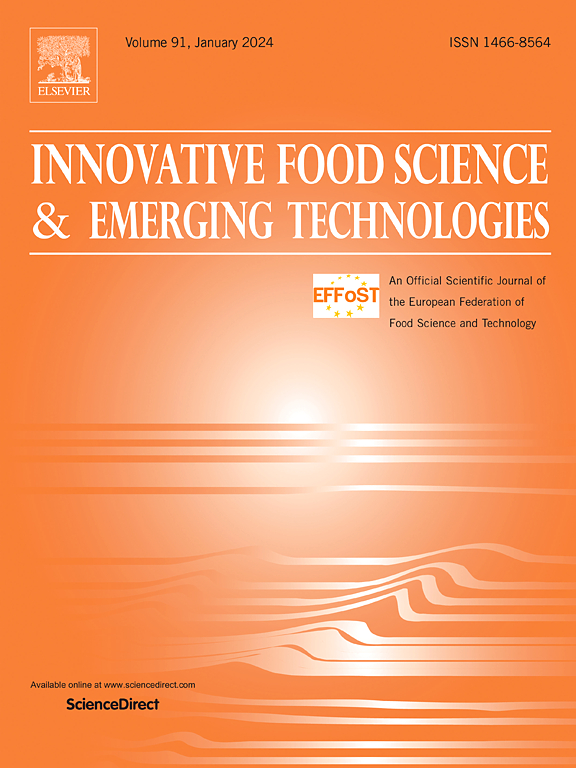农业食品中多菌灵快速定量分析的便携式电化学检测系统
IF 6.8
1区 农林科学
Q1 FOOD SCIENCE & TECHNOLOGY
Innovative Food Science & Emerging Technologies
Pub Date : 2025-06-17
DOI:10.1016/j.ifset.2025.104090
引用次数: 0
摘要
多菌灵是农业上使用的杀菌剂。它的污染危害健康,因为它被归类为致癌化合物。食品法典委员会(CAC)制定了多菌灵使用条例。然而,由于先进的仪器和操作,现有的分析方法难以实现。在这里,我们提出了一种简单、快速、低成本的方法,包括1)一个敏感的丝网印刷碳- 50% AuNP电极,2)一个0.04 M pH为5.0的Britton Robinson缓冲液的工作溶液和一个样品制备程序,用10 g作物和20 mL工作溶液提取15分钟,3)一个内部便携式恒电阻器,可以立即提供结果。这种电化学传感器在差分脉冲伏安法模式下直接定量多菌灵的氧化,证明了与商业紧凑的恒电位器相当的效率。多菌灵的检测范围为0.05 ~ 5 mg/kg (r2 = 0.983),检出限为0.246 mg/kg。多菌灵污染的新鲜水果模型(包括番茄、葡萄和辣椒)表明,我们提出的多菌灵检测方法与UPLC-MS/MS分析具有良好的相关性(r2 = 0.818)。每个测试的成本约为1.50美元,可以在室温下储存在拉链塑料袋中超过7个月。我们提出的设备是多菌灵快速测试发展的一个进步,使其适用于食品和农产品的现场应用。本文章由计算机程序翻译,如有差异,请以英文原文为准。

A portable electrochemical detection system for rapid quantitative carbendazim analysis in agricultural food
Carbendazim is fungicide used in agriculture. Its contamination harms well-being due to its classification as a carcinogenic compound. Codex Alimentarius Commission (CAC) has established regulations for carbendazim use. However, the current analytical methods are hard to implement due to the advanced instruments and operations. Here, we proposed a simple, rapid, and low-cost method consisting of 1) a sensitive screen-printed carbon-50 % AuNP electrode, 2) a working solution of 0.04 M Britton Robinson buffer pH 5.0 with a sample preparation procedure, extracting for 15 min by 10 g of crops with 20 mL of working solution, 3) an in-house portable potentiostat enabling immediate result delivery. This electrochemical sensor directly quantifies the oxidation of carbendazim in differential pulse voltammetry mode, demonstrating efficiency comparable to the commercial compact potentiostat. Our proposed carbendazim assay had a detection range of 0.05 to 5 mg/kg (r2 = 0.983), with a limit of detection (LOD) of 0.246 mg/kg. The carbendazim-contaminated fresh fruit models, including tomatoes, grapes, and chilis, demonstrated an excellent correlation between our proposed carbendazim detection method and UPLC-MS/MS analysis (r2 = 0.818). Each test costs approximately USD 1.50 and can be stored in a zip-lock plastic bag at room temperature for over seven months. Our proposed device is a step forward in the development of rapid carbendazim tests, making it suitable for field applications in food and agricultural products.
求助全文
通过发布文献求助,成功后即可免费获取论文全文。
去求助
来源期刊
CiteScore
12.00
自引率
6.10%
发文量
259
审稿时长
25 days
期刊介绍:
Innovative Food Science and Emerging Technologies (IFSET) aims to provide the highest quality original contributions and few, mainly upon invitation, reviews on and highly innovative developments in food science and emerging food process technologies. The significance of the results either for the science community or for industrial R&D groups must be specified. Papers submitted must be of highest scientific quality and only those advancing current scientific knowledge and understanding or with technical relevance will be considered.

 求助内容:
求助内容: 应助结果提醒方式:
应助结果提醒方式:


